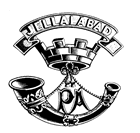
Albert Ernest Hole

8th Battalion
Private 21745
 | Albert Ernest Hole |  |
| Somerset Light Infantry 8th Battalion Private 21745 | ||
| Died 23rd April 1917 |
Albert Hole's Parents | ||
|
Albert Ernest Hole was the third child of Albert & Elizabeth Hole, born in 1896. Albert’s father, Albert Hole (senior), originally came from Lamyatt, one of a relatively small family of four, whose father in turn was a carter / farm labourer. Albert’s mother, Elizabeth (née BARTER), was from Wyke Champflower. Wyke and Lamyatt are neighbouring rural villages near Bruton, with every opportunity for the families to have known each other. Elizabeth’s father’s occupation was as a gatekeeper on the railway. Wherever the railway - in this case the Somerset & Dorset Joint railway - crossed the road, someone had to manually open and shut the level crossing gate for each train. They would have been alerted to the approach of a train by a bell mechanism. Owing to the frequency of this occurrence, the gatekeeper usually lived in a cottage built specifically to house the person fulfilling this function.There is a point just to the west of Wyke Champflower where the Somerset & Dorset railway crossed the lane from Castle Cary; one assumes that this was the crossing tended by Elizabeth's father, William Barter and that the cottage there was the Barter home in the early years of Elizabeth’s life. Hence everyone regularly crossing the railway at this point would have known the gatekeeper as there would often have been a few moments to kill while awating the passage of the train. | ||
|
At age 14, in 1881, Elizabeth was at school at ‘Hugh Sexey’s Hospital’ in Bruton. This school still operates today as a private school. |
The Hole Family |
|
Albert (senior) and Elizabeth were married on Christmas Day 1890 in Lamyatt. Albert’s detail on the marriage certificate show that he was already living in East Twerton (we don't know where; he may have been lodging and therefore not listed in directories) and working as a fireman on the railway at that time. He had grown up very close to the Somerset & Dorset line and clearly had connections with people who worked for the company. The 1891 census shows Albert (senior) and Elizabeth living
at 79 West Avenue. Eldest daughter Susie was born in the same year. Soon
afterwards (by 1894) the family had moved two doors away to 81 West Avenue –
where they remained until 1911 – and Bertha was also born in 1894. |
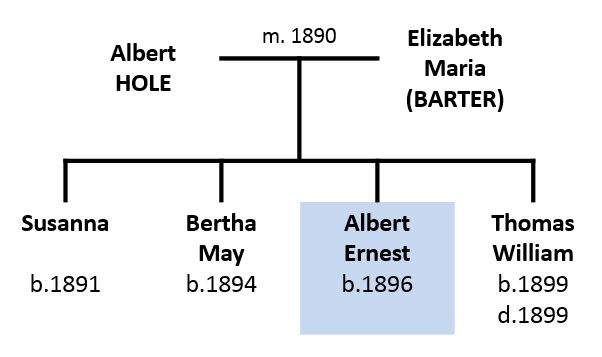 |
|
Albert Ernest (Albert
junior) was born in 1896. The Bath birth register shows another boy born in 1899 called Thomas Hole, with the mother’s maiden name ‘Barter’. ‘Thomas’ was also the name of the paternal grandfather. In the 1911 census, which required the head of household state the number of children born within any marriage and the number still living, only three are listed in each case. The birth of a Thomas Hole in 1897 could be coincidence, or it could be that the 1911 census form was not clearly understood by Albert (senior) and therefore incorrectly completed. Such erroneous completion of census forms is not rare. In 1904, at the age of about 8, Albert
is named in the South Twerton school prize-giving lists as being in
Standard I and having received Lady Tweedmouth's scripture
prize/certificate. |
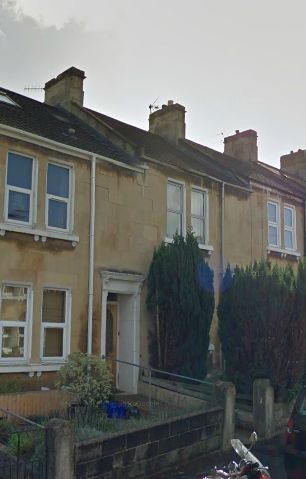 | ||
|
81 West Avenue, the Hole family home throughout Albert’s childhood |
|
Albert (senior) worked throughout this period as a fireman on the Somerset & Dorset Joint Railway and we know that he later became an engine driver on goods trains. The Somerset & Dorset railway ran up around the edge of Oldfield Park on what is now the line of the Linear Park / Two Tunnels greenway. So when Albert (junior) was in lessons in school, he would probably have been able to hear trains passing beneath the bridge at Claude Avenue on which his father was stoking the fire to provide steam for the steep climb up towards Devonshire Tunnel. The other thing we know from mentions of the various Sunday school union prize-givings in the local newspaper was that the family was associated with Oldfield Park Methodist Church. This was the large building on the corner plot opposite Brook Road railway bridge, which has now been converted to flats. |
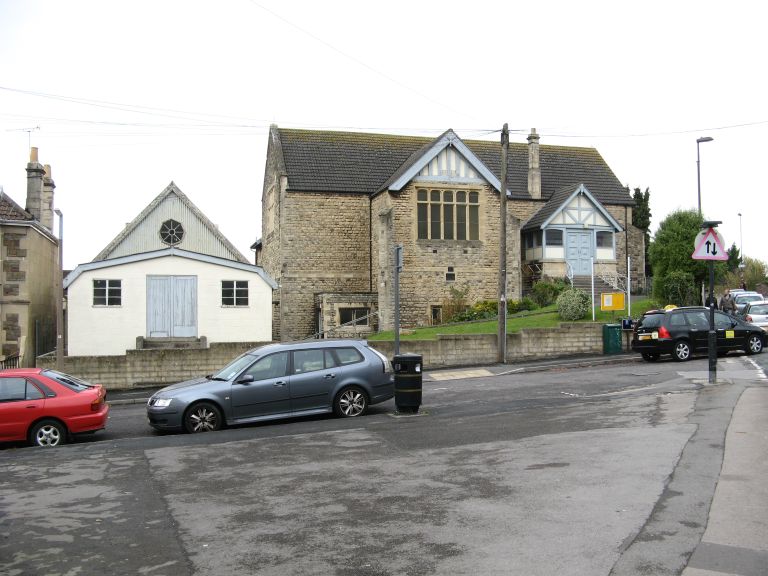 | ||
|
The Hole family attended Oldfield Park Methodist Church, seen here before its recent conversion to flats. A new house has now also replaced the tin church hall. [Image: commons.wikipedia.org] |
Albert’s elder sisters were both going out to work at the time of the 1911 census. Susie was a milliner and Bertha was a dressmaker. In 1912, the family moved to 43 Cynthia Road, with the back garden backing on to the railway on which Albert (senior) worked.We know from Albert's inclusion on the Twerton Co-operative Society memorial that he was employed there prior to enlisting. |
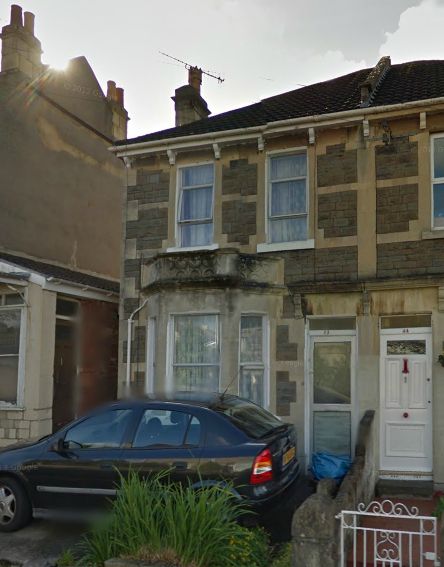 | ||
Albert Hole in WW1 | ||
Somerset Light Infantry
Albert enlisted with the 8th Battalion of the Somerset Light Infantry with the serial number 21745. [Note that the Bath Chronicle & Weekly Gazette of September 1914 listed an 'A. Hole' of St Mark's Parish as having joined the Army Serviice Corps. Firstly, Albert did not live in that parish (West Avenue and Cynthia Road were in Twerton) and secondly there are other men whose names fit the bill and who were living in Widcombe at the time]. The 8th Battalion of the SLI was raised in October 1914 and initial training took place in Leighton Buzzard. In terms of active service, 8th SLI were originally with 63rd Brigade, (21st Division) until July 1916, thereafter with 37th Division (exchanged for 110th Brigade). (More details pending). | ||
Albert Hole's Death | ||
23rd April saw the 63rd Brigade attack on Greenland Hill (near Fampoux). This from the unit war diary:OPERATIONS 22nd APRIL 1917 On 22.4.17, the 8th Battalion, Somerset Light Infantry were resting in trenches (LAUREL, CAM, EFFIE) in France 51B N.W. H.9. LAUREL Trench was submitted to a heavy gas shell bombardment from 12.05 a.m. to 4.00 a.m., with desultory gas shelling until 6.00 a.m. At 11.15 p.m. Companies moved forward independently to the assembly trenches in H.11.c and thence at 3.00 a.m. 23.4.17 to in front of HYDERABAD WORK in H.12.a & c. At Zero hour, the battalion was not in touch with the 8th Lincolns as the 8th Lincolns were on the right of HYDERABAD WORK in H.11.c in touch with the Black Watch of the 51st Division. For this reason, in the first hour after Zero the 8th Lincolns was in support to the 8th Somerset L.I. As the attack moved forward, the 8th Lincolns came up on the left of the 8th Somerset L.I. The 8th Somerset L.I. with the 4th Middlesex in front pressed straight on to the cross roads at I.7.a.5.3. During this period the Battalion H.Q. of the 8th Som.L.I. was in CLYDE TRENCH, with the Lincoln HQ just behind. Progress during the morning was slow, owing to direct rifle and machine gun fire. By noon the 8th Lincoln HQ had reached CUBA TRENCH or its vicinity, having worked round by H.6.d but a party of our troops were still held up by a party of 50 or 60 Germans entrenched about H.12.b.8.2. These surrendered to the O.C. 8th Lincolns who, accompanied by 2 orderlies, approached them from the rear. The 8th Somerset L.I. meanwhile, had collected their main body in the Sunken Road south of the X roads in I.7.a under the command of Captain Saunders and 2nd Lt Owen, the only two officers who remained in action until relieved. Lt Col J.W. Scott, his Adjutant, Headquarters and the remainder of the Battalion were at about I.7.1.1 .(sic). At this stage, the Adjutant was wounded and Lt Col J.W. Scott was killed, while the enemy in artillery formation came down over GREENLAND HILL to a trench about 800 yards of the Sunken Road running from I.7.a.2.8 to I.7.c.7.8 and parallel to it. Capt M.K.F. Saunders collected all Somersets and dug in CLASP TRENCH where he was relieved on the night 24/25.4.17. The 4th Middlesex were about 300 yards in front of the Somersets. Capt Saunders established connection with the Lincolns on the left and the troops (112th Bde) on his right. Owing to the lie of the ground between the X roads at I.7.a.5.3 and I.2.c.3.5, the Somersets and Middlesex on the one hand and the Lincolns on the other believed that they had alone pressed forward with both flanks unsupported. This false impression was corrected at noon 23.4.17. The afternoon of 23.4.17 was spent by the 8th Somersets in the consolidation of CLASP TRENCH. The relief was accomplished the same night without incident, the Battalion returning to HERON TRENCH about 200 strong in other ranks with Capt Saunders and 2nd Lt Owen. The 8th Somersets casualty returns for
the period 20th - 29th April were combined as they were in the front line for
the duration of this time and the Regimental History on page 184 notes that
losses were: 2 Officers and 17 O/R killed, 4 Officers and 180 wounded and 99 O/R
missing.
Albert Hole was among the 99. An item in the South Twerton school magazine in July 1917 seems to show that his parents only received news months later that their son was 'missing'. it is not known when they learned for certain that Albert had been killed. | ||
Burial | ||
| Albert Hole is buried in Cabaret-Rouge British Cemetery in Souchez. From the Commonwealth War Graves Commission: "Caberet
Rouge was a small, red-bricked, red-tiled café that stood close to this
site in the early days of the First World War. The café was destroyed
by shellfire in March 1915 but it gave its unusual name to this sector
and to a communication trench that led troops up the front-line.
Commonwealth soldiers began burying their fallen comrades here in March
1916. The cemetery was used mostly by the 47th (London) Division and
the Canadian Corps until August 1917 and by different fighting units
until September 1918. It was greatly enlarged in the years after the
war when as many as 7,000 graves were concentrated here from over 100
other cemeteries in the area. For much of the twentieth century,
Cabaret Rouge served as one of a small number of ‘open cemeteries’ at
which the remains of fallen servicemen newly discovered in the region
were buried. Today the cemetery contains over 7,650 burials of the
First World War, over half of which remain unidentified." | ||
|
In July 2016, Albert Hole's grave at Cabaret Rouge cemetery was visited by Mike & Kathy Sumsion of Bath, who have kindly supplied the following photographs of the cemetery and of Albert Hole's headstone. It is wonderful to know that the memory of this personal sacrifice - just one of so many - is being kept alive. Many thanks to Mike for the images. |
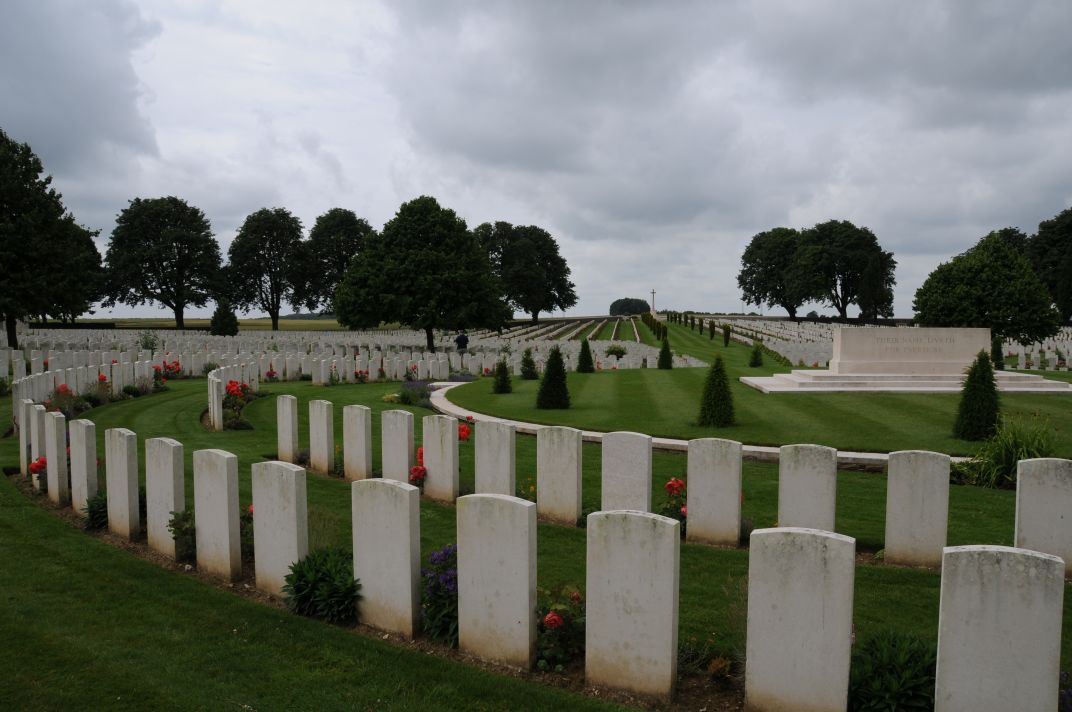 | ||
|
|
Decoration |
|
Albert Hole's medal card does not give a date when he first entered a 'theatre of war', but does shows that he received the British War Medal 1914-18 and the Allied Victory Medal posthumously. |
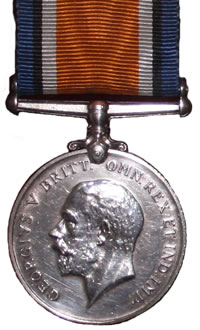 | 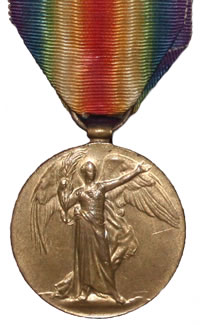 | ||
| British War Medal 1914-18 | Allied Victory Medal |
Commemoration | ||
 In addition to his commemoration on the South Twerton School memorial, Albert Hole is commemorated as follows: | ||
|
Bath War Memorial See separate page for details of the Bath War Memorial. Albert Hole's inscription: |
 |
|
Oldfield Park Methodist Church Memorial (now at Southdown Methodist) Oldfield Park Methodist Church stood at the western end of the Triangle in Oldfield Park but was recently converted to accommodation. The congregation merged with that at Southdown Methodist Church, The Hollow. The WW1 memorial plaque has been saved and is now on display (as is the church's WW2 memorial) at the Southdown church. Sadly, the church has not seen fit to display the plaque in the body of the church or even in the vestibule. It is tucked away in a corridor, but church members will be happy to take you to it. Albert Hole is commemorated on the plaque along with two other South Twertonites William Membery and Arthur Naish: |
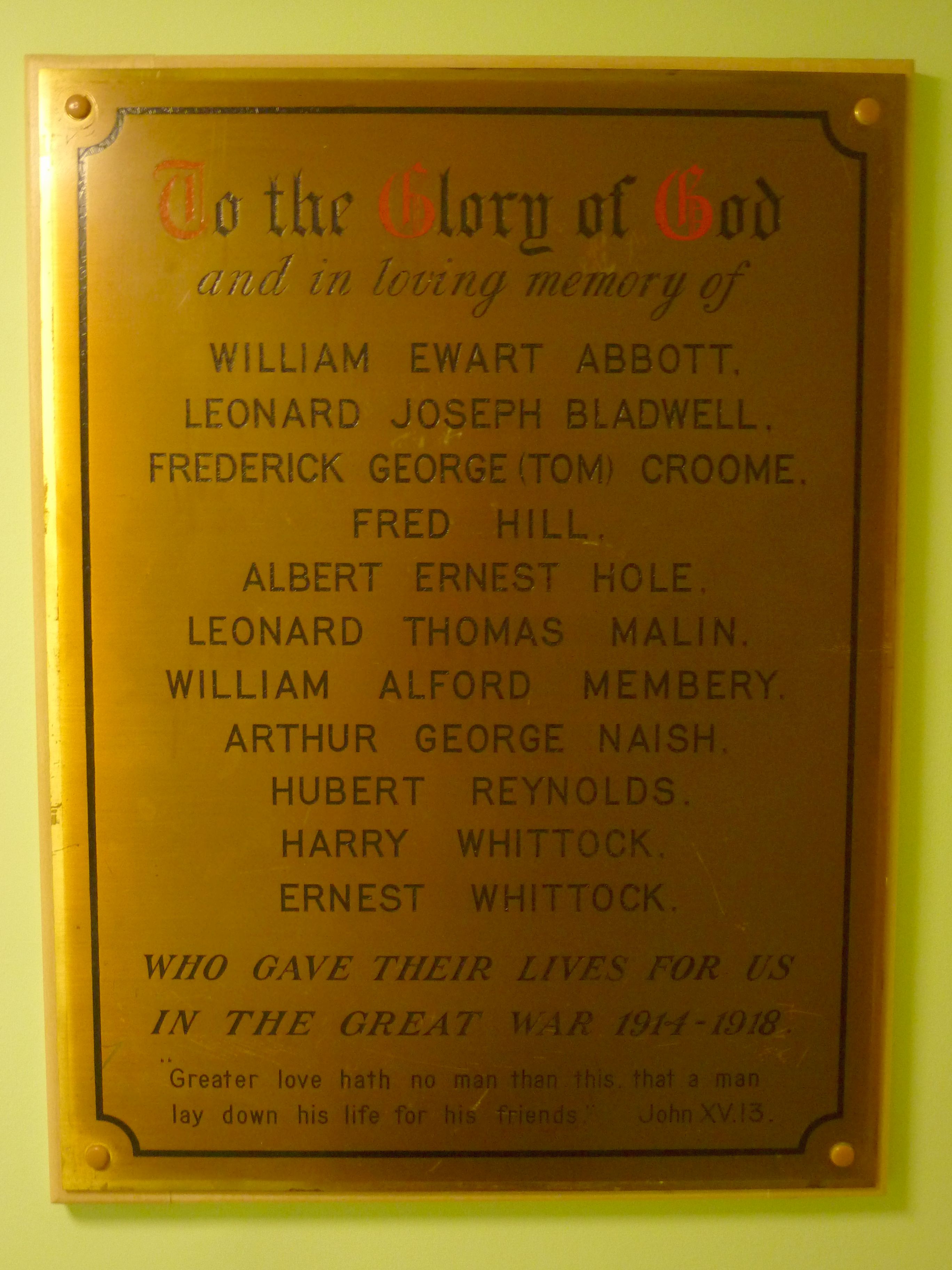 |
| Twerton Co-operative Society (now in the Museum of Bath at Work) Headquartered in Twerton High Street, the Co-operative Society was a well-known local grocer and would have employed staff in numerous roles including retail, delivery etc. Albert Hole is listed on the Twerton Co-op memorial: |
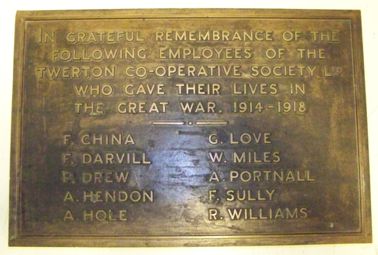 |
|
Somerset Light Infantry, 8th Battalion Memorial (Bath Abbey) On a pillar between the nave of the Abbey and the north aisle, there is a plaque to the memory of the servicemen of the 8th Battalion. Above hangs the battalion Colours. The story and photographs relating to the deposition of the Colours in the Abbey is told in the history of William Gould. Sadly, the plaque - supposed to be a memorial tribute to men who gave their lives - is partly obscured by straps and wires relating to the Abbey's flat screen TV system. With a little more care, these could have been placed in a way that did not interfere with the view of the plaque. Indeed, the Abbey is currently doing a fairly poor job with several of its WW1 memorials:
|
| 37th Division Memorial There is a memorial to all fallen soldiers of 37th Division in Monchy-le-Preux: |
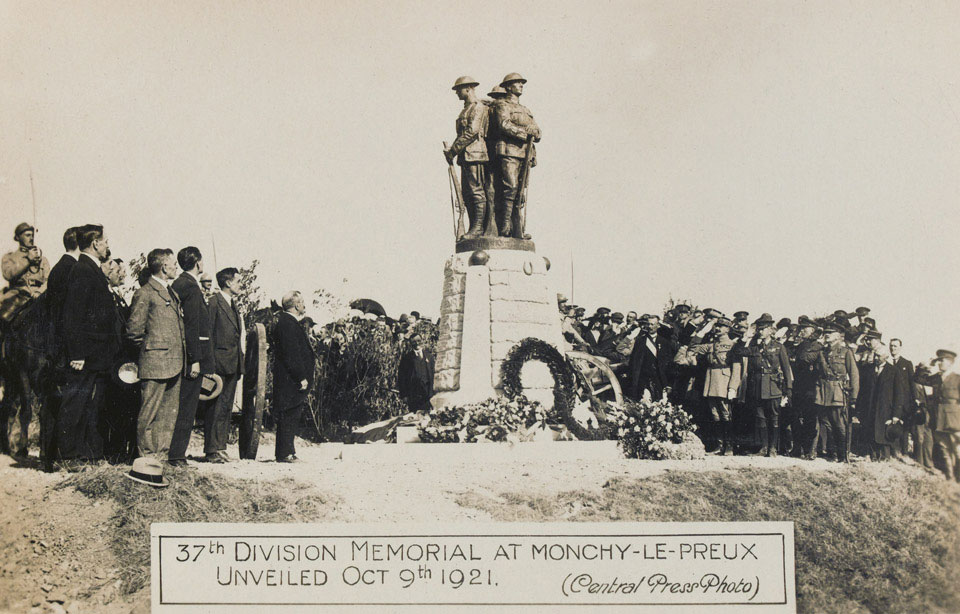 Image: National Army Museum, London |
Further Information |
After the warWe know that Albert’s
mother, Elizabeth, died in 1919 and that his sister Bertha May remained
unmarried, looking after his father at the family home in Cynthia Road. Albert (senior) died in 1932, being found dead on the embankment of the railway on which he had worked all his life. The Bath Weekly Chronicle & Gazette of 24th December 1932 carried the details of the inquest that determined that his death was caused by a heart attack as he carried ashes from the fire to his allotment at the rear of the house, which bordered onto the railway. The article also gave details of his funeral and the attendance of representatives of the Oldfield Park Methodist Church, the Oldfield Park Brotherhood (a local non-conformist men’s group) and the Somerset & Dorset Joint Railway; he had had significant links with each of these organisations. There is a family grave in Twerton cemetery (Bellotts Road) with burials of both parents and two of Albert's sisters: Living relativesIt would be great to hear from any living relatives of Albert Hole. Any relatives are likely to be distant (cousins etc.), however. Susie Hole (sister) became Susie Bristow on marriage in 1915 but died in Wimbledon in 1925 and the death announcement of the time makes no mention of children. Albert's other sister Bertha Hole died a spinster in 1949. Please get in touch!If you have any further information on Albert Hole, or want to suggest corrections / improvements for this page, please use the Contact page to get in touch.All additions and further information will be credited appropriately. AcknowledgementThanks to Mr David Carter, who supplied info on Albert Hole's commemoriation on the Twerton Co-operative Society memorial and the photograph of that memorial. Also to Mike Sumsion for visiting Albert Hole's grave in France in July 2017 and for supplying photographs. |